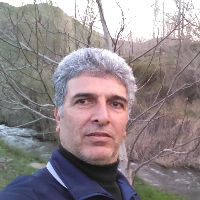A Critique and Analysis of Periodization and Chronology of the Central Iranian plateau With emphasis on the 4th millennium BC
Author(s):
Article Type:
Research/Original Article (دارای رتبه معتبر)
Abstract:
The main subject of periodization, cultural classification and archaeological chronology is the temporal and spatial patterns of material culture collections (Lucas, 2001, 106-141). The assemblages of archaeological sites and their components have a great importance in the chronological division and periodozation, because they are basic materials of the cultural similarities comparing. Therefore, any error in identifying the internal patterns of these components, which have an inherent conjunction with their spatial and temporal dimensions, will have a direct reflection on wider spatial and temporal patterning that are based on. The prehistoric chronology of the Iranian Central Plateau, especially due to its vast geographical scope, has been one of the cases that faced by such a challenge. Over the recent three decades, there have been many archaeological excavations and surveys in this area, that most of them have focused on prehistoric periods and their chronologies. Despite the good quantity of the recent decades archaeological activities on the vast area of the Iranian Central Plateau, its prehistoric chronologies and periodizations that generally have based on tape Sialk’s more than eighty years old and not so detailed divisions, has not changed much. According to this division, Girshman divided the chronology of the tape sialk, from the Neolithic period to the beginning stage of the Bronze Age (the Proto Elamite period) into four cultural periods and seventeen sub-periods or strata (Sialk I1-IV2). The fourth millennium BC, as the main subject of this paper, includes the sub-periods of Sialk III4-5, Sialk III6-7b, Sialk IV1, and parts of Sialk IV2. In particular, the second half of this millennium includes important sociopolitical developments that have played a major role in increasing social inequalities, the formation of early states, the proto literate and some technological changes, such as the production and use of bronze objects. The division of this sensitive phase between the sialk III6-7b and IV1-2 strata is in a way that emphasizes on the serious discontinuity between this two cultural periods. Regardless of whether the detection of this discontinuity is correct or not, the way in which these sub-periods are distinguished and differentiated have always been unclear and very generalized. So that, for example, the sialk stratum III6 has never been individually mentioned and has always been considered participant with the sialk III7. Of course, Silk's multiple chronological problems are not limited to that. While the sialk divisions was based on architectural strata, its comparative studies have all been based on ceramic styles, which has led to many errors in the process of inter-regional transformations and their chronological recognition. Most of these problems seem to be caused by insufficient attention to short-term Transformations processes. The results of recent studies for providing a precise and appropriate image from the process of cultural transformation of various prehistoric periods in this area, has indicated the inability of such a generalized divisions, due to the lack of attention to the short-term cultural events and the inflexible normative perception of the concept of culture. While over the past century, due to the great changes in the definition of the concept of cultural change and its various stages chronology and periodization, archaeological studies in the interests of the inter-regional and site distinctions and short-term criteria endorsement, passed over the old rigid normative and generalized definitions of culture. This studies, over acceptation the fluidity of the temporal and spatial dimensions of cultural boundaries, have added to their carefulness in the recognition and differentiation of cultural processes. Continued studies of excavations such as tape Meymoon-abad, presenting sufficient evidence of such that errors, which emphasize on the necessity of review the Iranian central plateau prehistoric periods old studies and their divisions.
Keywords:
Language:
Persian
Published:
Iranian Archaeological Research Journal, Volume:8 Issue: 19, 2019
Pages:
47 to 66
magiran.com/p1945927
دانلود و مطالعه متن این مقاله با یکی از روشهای زیر امکان پذیر است:
اشتراک شخصی
با عضویت و پرداخت آنلاین حق اشتراک یکساله به مبلغ 1,390,000ريال میتوانید 70 عنوان مطلب دانلود کنید!
اشتراک سازمانی
به کتابخانه دانشگاه یا محل کار خود پیشنهاد کنید تا اشتراک سازمانی این پایگاه را برای دسترسی نامحدود همه کاربران به متن مطالب تهیه نمایند!
توجه!
- حق عضویت دریافتی صرف حمایت از نشریات عضو و نگهداری، تکمیل و توسعه مگیران میشود.
- پرداخت حق اشتراک و دانلود مقالات اجازه بازنشر آن در سایر رسانههای چاپی و دیجیتال را به کاربر نمیدهد.
دسترسی سراسری کاربران دانشگاه پیام نور!
اعضای هیئت علمی و دانشجویان دانشگاه پیام نور در سراسر کشور، در صورت ثبت نام با ایمیل دانشگاهی، تا پایان فروردین ماه 1403 به مقالات سایت دسترسی خواهند داشت!
In order to view content subscription is required
Personal subscription
Subscribe magiran.com for 70 € euros via PayPal and download 70 articles during a year.
Organization subscription
Please contact us to subscribe your university or library for unlimited access!



